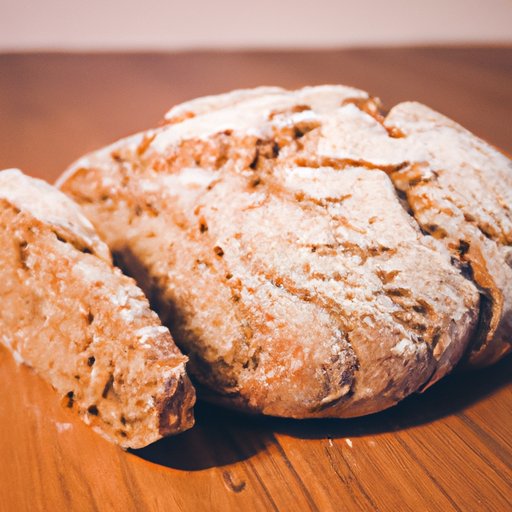
I. Introduction
Gluten-free bread has become increasingly popular in recent years as more and more people are diagnosed with celiac disease or gluten sensitivity. However, many people still have questions about what gluten-free bread is, why it’s necessary, and how it compares to traditional bread. In this article, we’ll explore all of these questions and more. Whether you’re new to the gluten-free lifestyle or you’re simply curious about this rising trend, this guide has everything you need to know about gluten-free bread.
II. The Basics of Gluten-Free Bread: A Simplified Guide for Beginners
Gluten-free bread is any type of bread that doesn’t contain gluten, which is a protein found in wheat, barley, and rye. For people with celiac disease or gluten sensitivity, gluten can cause damage to the small intestine and lead to a range of symptoms such as fatigue, digestive problems, and joint pain. Gluten-free bread allows these individuals to eat bread without any health complications.
There are several reasons why someone may choose to eat gluten-free bread. Apart from celiac disease or gluten sensitivity, some people may choose to eat gluten-free bread as part of a low-carb or paleo diet. Others may simply prefer the taste or texture of gluten-free bread.
There are many different types of gluten-free bread available in the market. Some of the most popular include rice bread, cornbread, potato bread, and almond flour bread. Each type of gluten-free bread has its own unique flavor, texture, and nutritional value.
III. Does Gluten-Free Bread Live up to the Hype? A Comparison to Traditional Bread
One of the most common questions about gluten-free bread is how it compares to traditional bread in terms of nutrition, taste, and texture.
When it comes to nutrition, gluten-free bread may have some pros and cons compared to traditional bread. Gluten-free bread is generally lower in carbohydrates, calories, and fiber than traditional bread. However, it may also be lower in certain nutrients such as folate, iron, and other B vitamins. It’s important to note that not all types of gluten-free bread are created equal, and some may be more nutritious than others.
In terms of taste and texture, gluten-free bread can vary widely depending on the type and brand. Some gluten-free bread may have a slightly different taste or texture compared to traditional bread, but many people find that they enjoy gluten-free bread just as much as traditional bread.
IV. Gluten-Free Bread for Everyone: A Comprehensive Overview of the Different Types Available
As mentioned earlier, there are many different types of gluten-free bread available in the market. Here’s a closer look at some of the most popular:
Rice Bread: made from rice flour and often mixed with other gluten-free flours, rice bread has a mild flavor and a light, fluffy texture.
Oat Bread: made from oat flour, oat bread is a good source of fiber and has a slightly nutty flavor.
Almond Flour Bread: made from almond flour and eggs, this type of bread is high in protein and healthy fats. It has a slightly sweet, nutty flavor.
Potato Bread: made from mashed potatoes and rice flour, potato bread has a soft texture and a slightly sweet taste.
When choosing a type of gluten-free bread, it’s important to consider both the taste and nutritional value. Some types of gluten-free bread may be higher in calories or fat than others, so it’s important to read the nutrition labels carefully.
V. Surviving Celiac Disease with Gluten-Free Bread: A Personal Story and Guide
Living with celiac disease can be challenging, but many people find that a gluten-free diet can improve their symptoms and overall quality of life.
A personal story helps people understand the journey of someone who has celiac disease. Many people with celiac disease rely on gluten-free bread as a staple in their diet. With tips on coping with celiac disease and making healthy gluten-free bread choices, this section will provide guidance and support to those who require a gluten-free diet.
VI. The Science Behind Gluten-Free Bread: A Deep Dive into Its Ingredients and Nutrition
Delving into the science behind gluten-free bread, this section will give a more detailed analysis of gluten’s effects on the body and how it led to the development of gluten-free bread. With a discussion of the substitutes used in gluten-free bread and an analysis of the different ingredients in gluten-free bread and their nutritional value, the section offers comprehensive insights into the science behind gluten-free bread.
VII. Gluten-Free Bread Making: Tips, Recipes and Techniques for Baking Delicious Bread Without Gluten
Making gluten-free bread can be a bit trickier than making traditional bread. This section will share tips and techniques for making delicious gluten-free bread at home. Tips such as using xanthan gum and using a dedicated gluten-free kitchen can help ensure your bread turns out perfectly. Furthermore, the section includes some delicious and popular recipes for gluten-free bread as well as common mistakes to avoid when baking gluten-free bread.
VIII. Conclusion
Gluten-free bread can be a great option for people with celiac disease or gluten sensitivity, as well as those who simply prefer the taste or texture of gluten-free bread. With so many different types of gluten-free bread available in the market, it’s important to choose wisely based on taste and nutritional value.
By exploring the science behind gluten-free bread, sharing personal stories, offering tips for baking gluten-free bread, and comparing it to traditional bread, this article aims to provide a comprehensive guide to gluten-free bread. We hope this guide will help you make informed decisions about your bread choices and help you appreciate all the delicious options available in the market.




